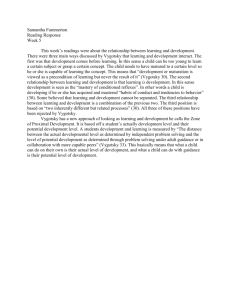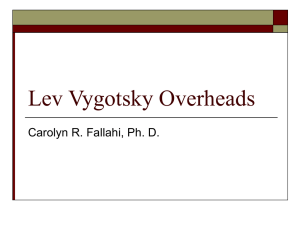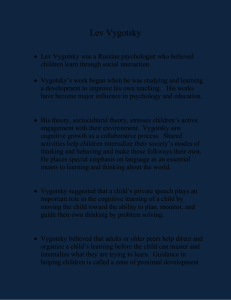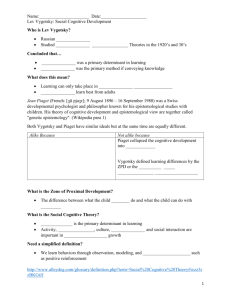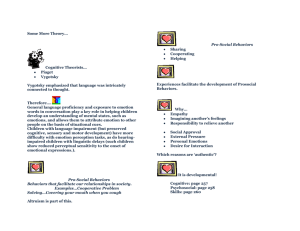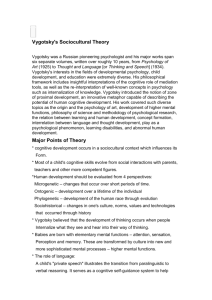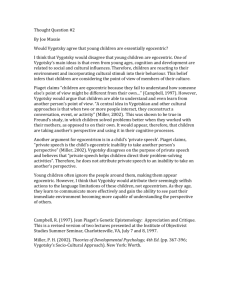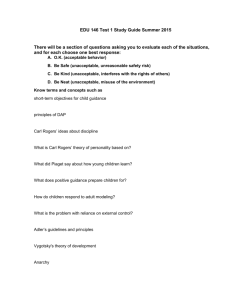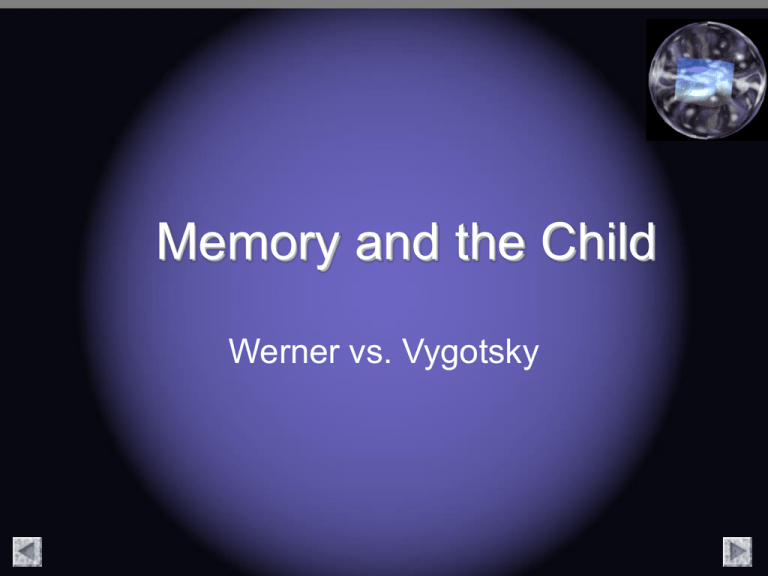
Memory and the Child
Werner vs. Vygotsky
Heinz Werner (1890-1964)
• Born in Vienna, Austria in 1890
• Bright and studious
• Loved music and planned to be
composer and music historian
• Class incident – changed major to
psychology and philosophy
• Gestalt philosophy
• Came to America in 1933
• 1947 – Professor at Clark
University
Biographical information from: Crain, William. Theories of Development: Concepts and Applications. Fifth Ed. New
Jersey: Pearson: Prentice Hall, 2005.
Werner’s Key Terms
•
•
•
•
•
Eidetic imagery
– The “pure memory image” of something, as if the image
in one’s mind is actually the percept itself.
Physiognomic perception
– The perception of an object from an emotional viewpoint,
as the child is affected by what he sees. It is the
attribution of expressive features to any object, even
inanimate.
Synesthesia
– The combination of more than one sense in perceiving
an object. This makes a rich, vivacious perception.
Geometric-technical perception
– The tendency to use objective and measurable
properties in perception. This is a completely abstract,
objective approach to perception.
Microgenetic mobility
– The ability of some adults to revert from geometrictechnical to physiognomic perception.
Heinz Werner – His Theory
• Discontiuous Development
– Orthogenic Principle
• Organic whole
• Differentiation
• Hierarchical integration
• Self-object differentiation
• Physiognomic Perception –
younger children
• Geometric-technical perception –
older children/adults
Lev Vygotsky (1896-1934)
• 1896 - Born and raised in Byelorussia
Republic
• Exceptionally bright child
• 1917 - Graduated from Moscow University
• 1917-1924 - Teaching
• 1924 - Stunning psychology presentation
• 1924-1934 Research and development of
theory
information
from: Dixon-Krauss,
Lisbeth. Vygotsky
in themuch
Classroom: Mediated
Literacy Instruction and
•Biographical
Works
not
published
until
later
Assessment. New York: Longman Publishers USA, 1996. pp.2-3
Vygotsky’s Key Terms
•
Natural mental behaviors
–
•
Cultural mental behaviors
–
•
“artificial, or self-generated, stimuli.”. Objects, behaviors, or other
stimuli which people use to augment their natural mental
capacities. They give people control over their mental behaviors.
Examples: language, reminders. When signs are used, behavior
is said to be “mediated behavior.”
Internalization
–
•
the culturally developed, higher mental actions that are unique to
humans. These behaviors are more complex and are self-directed
.
Signs - psychological tools –
–
•
the elementary, biological abilities of the brain. This and other
“lower…mental behaviors,” according to Vygotsky, are shared
with some animals.
The progressive transfer from external social activity mediated by
signs to internal control.
Semiotic mediation
–
The process by which, through the use of signs, natural mental
behaviors are developed into higher, cultural, mental behaviors
Definitions from Vygotsky, Mind in Society, Dixon-Krauss, Vygotsky in the Classroom: Mediated Literacy Instruction and
Assessment, Bodrova, Tools of the Mind: The Vygotskian Approach to Early Childhood Education., and Crain textbook.
Lev Vygotsky – His Theory
• Sociohistorical theory of development
•
There are two lines of development: “the elementary processes,
which are of biological origin…and the higher psychological
functions, of sociocultural origin…The history of child behavior is
born from the interweaving of these two lines.” - Mind in Society
•A. Leontiev’s study on mediated memory
–Younger children – little or no use of signs
–School-age children – use of external signs
–Adults – internalized use of signs
Werner and Vygotsky’s views on
memory
Werner
“As one would expect,
the capacity for
retention during
childhood has been
found to increase
with age… We know
at least one of the
principal causal
factors: viz., the
growing capacity of
the child to organize
material to be
retained.”
Vygotsky
“In the elementary
form something is
remembered; in
the higher form
humans
remember
something.”
Guiding Questions
• Is it really true that older
children, whom Vygotsky would
say have culturally acquired
better memory skills, but who no
longer have the richness of
perception and eidetic imagery
that Werner says younger
children possess, will remember
more than the younger
children?
• Will a structured, logical
approach to memory hinder the
natural ability of the younger
children while assisting the
I.
The kindergartners will do
better overall
II. The kindergartners’ scores
will not improve when they
are asked to remember.
III. The third graders’ scores
will improve when they are
asked to remember
Procedure
• 5 Kindergartners and 5 Third
Graders
• 2 Scenes
– Farm Scene
• Discussion of objects and details
• Not told beforehand to try to remember
• Asked how they remembered
– Beach Scene
• Discussion of objects and details
• Told beforehand to try to remember
• Asked how they remembered
The Scenes
# 2: Beach Scene
# 1: Farm Scene
Scoring
• Object remembered correctly: +1
point
• Detail remembered correctly: +1
point
• Incorrect object or detail: -1 point
The Result
Overall
Overall
First Time
Second Time
Overall
Kindergartners
41.4
39.6
40.5
Third Graders
47.0
45.2
46.1
The Scores – Kindergarten and Third
Kindergartners' Scores
60
First Time
Second Time
Difference
Ryan Jackson
54
37
-17.0
40
Lauren Jeter
45
37
-8.0
30
50
First Time
Second Time
35
-4.0
10
Tracy Ho
35
48
13.0
0
Sam Denehee
34
41
7.0
Average
41.4
39.6
-1.8
Third Graders' Scores
Sa
r
39
R
ya
La n
ur
en
Sara Huerta
a
Tr
ac
y
Sa
m
20
70
First Time
Second Time
Difference
Elizabeth M.
62
52
-10.0
Maria Lynn
49
42
-7.0
Joe Ramirez
46
43
-3.0
Marisa Hantelmann
40
45
5.0
Timmy Cruz
38
44
6.0
Average
47.0
45.2
-1.8
60
50
40
30
20
El
iz
ab
et
h
M
ar
ia
Jo
M e
ar
is
Ti a
m
m
y
10
First Time
Second Time
How the Kindergartners
Remembered
“I watch TV a lot.”
“TV again. ‘Cause I can remember
34 - 37 it.”
Sam
Because I think in my brain, and I think
Tracy quietly.”
35 - 48 “Because I thinked, and I thinked really
hard. And tried to remember.”
“That was easy, because I looked, and
brain was telling me.”
Ryan “I was looking very carefully, and my
54 - 37 were turned on , and my brain was
on.”
“I picture them in my mind.”
Sara “I tried to remember. I pictured them in
39 - 35 mind.”
“Because I looked at it really good.”
How the Third Graders
Remembered
Timmy
38 - 44
Joe
46 - 43
Elizabet
62 - 52
Marisa
40 - 45
“I looked at them, then tried to remember
I just tried to remember.”
“By looking at them really hard and trying to
memorize them. Like look at it two times,
then after you’re done, you can close your
and try to think of it.”
“By memorizing it. ‘Cause the color they
and the animal they are. I pictured them in
head.”
“I pictured them in my head. And I
them, in my memory.”
“By seeing the pictures, and not forgetting
they were.”
“By putting them into my head and by
at the pictures for a minute, and by taking a
picture of them.”
“I just pictured them in my mind.”
“Just by memorizing them in my head. I just
them in my head and keep thinking about
“By looking at the background of the farm.
Conclusions
I. K over 3rd overall:
• WRONG!
II. K wouldn’t improve:
• RIGHT!
III. 3rd would improve:
• WRONG!
Limitations
• Distractions
• Kindergartners and third
graders too close in age
• Should have encouraged the
children to give more details
on their own, when discussing
the picture the first time
Other Questions
• How much of a difference does it
make when things to be
remembered are discussed, and
not just seen? What about the
other senses?
• Which played a more significant
role in memory: Werner’s
development, or Vygotsky’s social
conditioning? Or a mixture of
both?
Links:
• Werner overview:
http://danielson.laurentian.caldrdnot
es/5106ch05.htm
• Vygotsky overview:
http://www.geocities.com/lorigranth/
>

